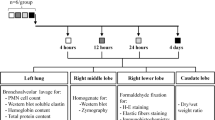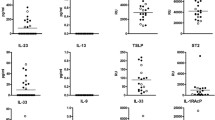Abstract
Objective
To test the hypothesis whether PMN-Elastase in bronchoalveolar lavage fluid (BALF) could reflect neutrophil activity in the lower respiratory tract.
Design
Prospectively, morphologic findings of acute and chronic inflammation in the transbronchial lung biopsy specimens were compared with the numbers of neutrophils in the BALF and the concentration of PMN-Elastase in the same.
Setting
Ambulatory outpatient service of bronchology and respiratory physiopathology and intensive care unit of a communal hospital.
Patients
50 ambulatory outpatients and 10 critically ill patients of the ICU, presenting infiltrative lung diseases.
Interventions
Transbronchial lung biopsies and bronchoalveolar lavage were performed through a fiberoptic bronchoscope. Venous blood samples were obtained after bronchoscopy.
Measurements and results
Biopsy specimens and cell count in the BALF were examined by light microscopy. PMN-Elastase and albumin were measured in the BALF-supernatant and in the plasma. C-reactive protein (CRP) and a1 proteinase inhibitor (a1-PI) were measured in the plasma. Intrapulmonary originating PMN-Elastase was calculated with reference to albumin. The results concerning acute inflammation obtained by transbronchial lung biopsy (TBLB) (n=16) correlated better with the levels of PMN-Elastase in the BALF (n=21) than with the neutrophil count (n=28) (p<0.5 versusp<0.025 for χ2). The sensitivities and specificities of the above methods were respectively 76.9%, 100%, 100% and 100%, 95.2%, 63.1%. The intrapulmonary originating PMN-Elastase was aboput 99.7% of the measured BALF-Elastase.
Conclusion
The PMN-Elastase concentration in the BALF is a more accurate indicator of the inflammatory intensity in the alveolar structures than in the number of neutrophils. It may therefore be useful to the clinican in his attempt to detect acute inflammation in the lower respiratory tract.
Similar content being viewed by others
References
Frank MM, Fries LF (1991) The role of complement in inflammation and phagocytosis. Immunology 12:326–332
Jochum M, Fritz H (1989) Pathobiochemical mechanisms of inflammation. In: Faist E, Ninnemann JL, Green DR (eds) Immune consequencs of trauma, shock and sepsis. Springer, Berlin Heidelberg, pp 164–172
Worthen GS (1987) Lipid mediators, neutrophils and endothelial injury. Reports from the second Grover Conference, Dekers, Colorado September 15–18, 1986. Am Rev Respir Dis 136:445–458
Donnelly SC, Haslett C (1992) Cellular mechanisms of acute lung injury: implications for future treatment in the adult respiratory distress syndrome. Thorax 47:260–263
Idell St, Kucich U, Fein A et al (1985) Neutrophil elastase-releasing factors in bronchoalveolar lavage from patients with adult respiratory distress syndrome. Am Rev Respir Dis 132:1098–1105
Crystal RG, Gadek JE, Ferrans VJ, Fulmer jd, Line BR, Hunninghake GW (1981) Interstitial lung disease: current concepts of pathogenesis, staging and therapy. Am J Med 79:542–568
Zavala DC (1978) Transbronchial biopsy in diffuse lung disease. Chest [Supp] 73:727–730
Kobayashi H, Matsuoka R, Kimatura S (1989) Complications of TBLB for diffuse lung disease. 6th World congress of bronchology, Tokyo. Book of Abstract, p70
Kindt GC, Weiland W, Davis B, Gadek JE, Dorinsky PM (1989) Bronchiolitis in adults. A reversible cause of airway obstruction associated with airway neutrophils and neutrophil products. Am Rev Respir Dis 140:483–492
Thorpe JE, Baughmann RP, Frame PT, Wesseler Fa, Stanecke JL (1987) Bronchoalveolar lavage for diagnosing acute bacterial pneumonia. J Infect Dis 155:855–861
Hubbart RC, Brantly BL, Crystal RG (1991) Proteases. In: Crystale RG, West JB et al (eds) The lung: scientific foundations. Raven Press, New York, p 1776
Katzenstein A, Askin FrB (1982) Surgical pathology of non neoplastic lung disease. Saunders, Philadelphia, pp 9–31
Fukuda Y, Ishizaki M, Masuda Y, Kimura G, Kawanami O, Masugi Y (1987) The role of intraalveolar fibrosis in the process of pulmonary structural remodeling in patients with diffuse alveolar damage. Am J Pathol 126:171–182
Poletti V, Patelli M, Poggi S, Bertanti T, Spigal L, Ferracini R (1988) Transbronchial lung biopsy and bronchoalveolar lavage in diagnosis of diffuse infiltrative lung disease. Respiratory 54:[Suppl 1] 66–72
Youden WJ (1950) Index for rating diagnostic test. Cancer 3:32–35
Dreher M, Gunzer G, Helger R (1987) A homogenous enzym immunoassay for human PMN-Elastase-α1-Proteinase-Inhibitor complex. Ann Clin Biochem 24:[Suppl 2] 162–164
Prior C, Barbe RA, Evans RM et al (1990) Lavage versus serum measurement of lysosyme, angiotensin converting enzyme and other inflammatory markers in pulmonary sarcoidosis. Eur Respir J 3:1146–1154
Killingsworth LM, Savory J (1973) Nephelometric studies of the precipitin reaction: a model system for specific protein measurement. Clin Chem 19:403–407
Sternberg JC (1977) A rate nephelometer for measuring specific proteins by immunprecipitin reactions. Clin Chem 23:1456–1461
Fujita I, Nakamura H, Yamagishi Y, Yamaji Y, Shiotani T, Irino S (1992) Elevation of plasma truncated elastase: α1-Proteinase-Inhibitor complexes in patients with inflammatory lung disease. Chest 102:129–134
The BAL Cooperative Group Steering Commitee (1990) Bronchoalveolar lavage constituents in healthy individuals idiopathic pulmonary fibrosis and select comparison groups. Am Rev Respir Dis 141:[Suppl] 169–202
Fujita J, Nelson NL, Daughton et al (1990) Evaluation of elastase and antielastase balance in patients with chronic bronchitis and pulmonary emphysema. Am Rev Respir Dis 142:57–62
May RM (1987) Chaos and the dynamics of biological populations. In: Berry MW, Percival IC, Weiss NO (eds) Dynamical chaos. Proceedings of the Royal Society of London. Princeton University Press, Princeton, New Jersey, pp 27–44
Author information
Authors and Affiliations
Rights and permissions
About this article
Cite this article
Lengas, A., Poletti, V., Pacifico, L. et al. Acute lung inflammation: Neutrophil elastase versus neutrophils in the bronchoalveolar lavage — neutrophil elastase reflects better inflammatory intensity. Intensive Care Med 20, 354–359 (1994). https://doi.org/10.1007/BF01720908
Received:
Accepted:
Issue Date:
DOI: https://doi.org/10.1007/BF01720908




